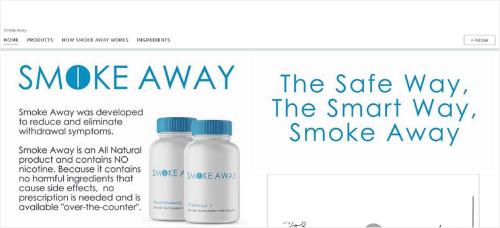The Opioid Addiction Recovery Fraud Prevention Act gives the FTC authority to seek civil penalties for unfair or deceptive advertising of products or services marketed to treat substance use disorders – and that includes addiction to tobacco. The FTC just announced a settlement with affiliated companies selling products under the “Smoke Away” brand and the man behind all those LLCs, Michael J. Connors. Do those names sound familiar? They should because this isn’t the first time the FTC has sued Connors for illegal conduct related to Smoke Away. This complaint alleges the defendants violated OARFPA and the FTC Act by making deceptive smoking cessation claims and by passing off actors as genuine users of the products. The proposed settlement – which includes a $7.1 million monetary judgment and a $500,000 civil penalty – imposes a lifetime ban that will put the “away” in Smoke Away and in Connors’ involvement in marketing addiction-related products or services.
All too often, tobacco addiction ends in death, but most smokers will tell you that snuffing out cigarettes for good poses a particular challenge. The defendants’ products – Smoke Away Formula 1 tablets, Smoke Away Maintenance tablets, Spray Away by Smoke Away homeopathic spray, and Smoke Away Homeopathic Pellets – contained various formulations of vitamins and botanicals, including alfalfa root, licorice root, cape aloe, white oak. The “Basic Kit,” which featured Smoke Away Formula 1 and Smoke Away Maintenance, typically sold for about $69.
The defendants pitched their products with a compelling message: “Don’t be a slave to cigarettes anymore. Quit Smoking for good. The safe way. The natural way. With the help of Smoke Away.” What’s more, ads claimed smokers would quit easily and quickly, including within seven days. According to the complaint, the defendants further promised instant relief from cravings thanks to “all-natural herbs” to “help you stay calm and comfortable in spite of the nasty withdrawal symptoms your body throws at you.” They disseminated those representations on websites they controlled, in social media platforms like Facebook and YouTube, in radio ads, via online advertising networks like Google Search Ads and Google Display Ads, and through text messages.

Skeptical of such dramatic results? Prospective customers didn’t have to just trust what the company claimed because ads also featured testimonials from people represented as real users of the product. A consumer named “Deborah” had this to say in a video about Smoke Away: “I, after a few days, did not even look for cigarettes or crave them. . . . Smoke Away, just thank you – thank you again for saving my life.” According to another consumer called “Andrew,” “Now I tried everything – the patch, the gum. You name it, I tried it. And nothing worked until I found Smoke Away.”
But according to the FTC, the defendants made numerous deceptive smoking cessation claims and failed to have substantiation to support their promises. What about those dramatic endorsements from “real” customers? Here’s what the complaint alleges: “[A]t least some of the individuals giving testimonials were not bona fide Smoke Away users, but rather actors that Defendants recruited.” The FTC says the defendants gave them a rough outline of what to say and encouraged them to take artistic license so they would seem “authentic.”
In addition to the financial remedy, the proposed order bans Connors and his companies from marketing or selling any product or service to treat any form of substance use disorder. How long is the ban in effect? Forever.
What can other companies learn from the FTC’s action?
The scope of OARFPA is broader than you may think. The word “opioid” is in the title of OARPFA – and the FTC has used the statute to challenge deceptive claims for products and services claiming to treat opioid use disorder – but the text of the law makes it clear that it covers the broad range of substance use disorders, including tobacco-related addiction. Given the personal toll and public health costs of addiction, the FTC will continue to put those claims under the microscope.
Consumer endorsers must be bona fide users of the product or service. The personal experiences of consumers who recommend a product can be uniquely persuasive to prospective customers. The FTC’s Endorsement Guides make it clear that people portrayed as real-life users must be just that. That’s how the FTC has interpreted Section 5 for decades and the just-announced revisions to the Endorsement Guides don’t change that fundamental compliance principle. What’s new is that this case establishes the FTC’s position that bogus consumer endorsements also violate OARFPA.
Companies may like repeat customers, but the FTC doesn’t. To paraphrase the old standard, “Love may be lovelier the second time around,” but once is more than enough when it comes to deceptive advertising. In 2005, the FTC challenged similar claims for Smoke Away made by defendant Connors and his now-defunct company Emerson Direct, which went by notable d/b/a “Council on Natural Health.” The lifetime ban in the current action should convey just how seriously the FTC views recidivism.
